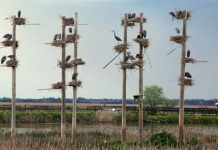SALT LAKE CITY, Utah, April 24, 2023 (Gephardt Daily) — State wildlife officials has announced a record number of big game animals were fitted with GPS collars this winter.
Those newly sporting the satellite tracking hardware range from 1,153 deer to 18 moose, the Utah Division of Wildlife Resources says.
“Each year, the DWR captures big game animals to perform important health assessments and to place GPS collars on the animals to learn more about their migration patterns and survival rates,” the agency said in a news release.
“This winter, a record 1,779 big game animals were captured, providing important data about big game herds across the state.”
The work, the Utah DWR says, also includes inserting transmitters into pregnant deer to alert biologists when a fawn is born.
The division has been conducting these captures and collecting data for the last 10 years in Utah, said the agency’s Big Game Projects Coordinator Kent Hersey. “We have learned a lot about deer and other big game animals during that time, which in turn, has informed our management decisions.
“The amount of body fat a deer has going into winter influences how well they survive the winter. The amount of body fat a female deer has coming out of winter can impact the weight of the fawn at birth and how fast the newborn fawn grows. Those things in turn help the overall population.”
“The GPS collars provide crucial data that informs planning for sustainable land use, transportation, energy, residential and commercial development, recreation and habitat improvement in a variety of areas across the state,” said Makeda Hanson, DWR Utah wildlife migration initiative coordinator in the released statement.
“One component of that is incorporating wildlife structures on the landscape to assist wildlife migration. Those structures include overpasses, bridges, culverts and fences.”
The big game animals captured during this research work include deer, elk, moose, bighorn sheep, bison and pronghorn. During the 2023-24 winter, the following animals were captured, assessed and released:
- Bighorn sheep: 209
- Bison: 27
- Deer: 1,153
- Elk: 305
- Moose: 18
- Pronghorn: 67
During captures in November and December, DWR biologists collect crucial data and analyze it. This includes:
- Measuring body fat and overall nutritional condition entering winter
- Sampling and testing for disease
- Estimating survival rates and cause of death for different animals
- Assessing migration patterns and learning the location of critical migration corridors
- Gathering information to better understand limiting factors for population growth
During the captures in March, the following research is conducted:
- Measuring body fat and overall nutritional condition exiting winter
- Checking pregnancy rates in doe deer
- Inserting transmitters into pregnant deer that alert biologists when a fawn is born so researchers can locate the newborn fawn and assess health, survival rates and cause of death (if the fawn doesn’t survive).
The captures typically take place between November and March, when the animals have migrated to lower elevations and are easier to locate. Another reason the captures take place during the winter is because big game animals have a hard time regulating their body temperatures, and the cool weather helps them recover more quickly. The animals are typically caught by a helicopter crew that uses a net gun, and then the animals are later safely released after the health testing.






